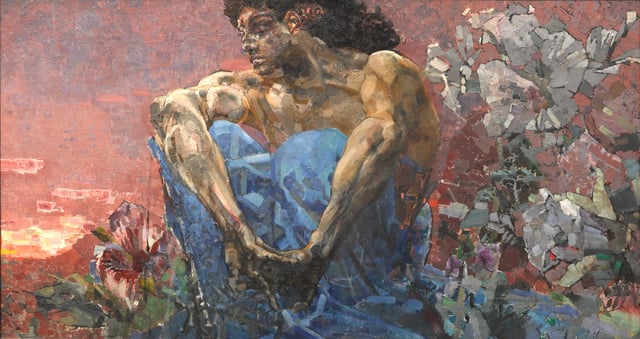Demon

Demon

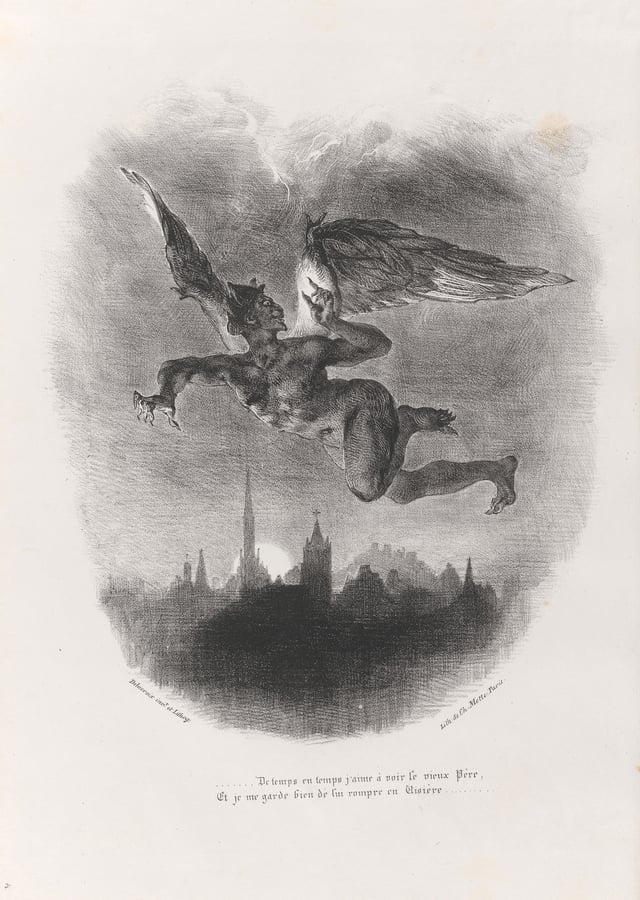
Mephistopheles (A Medieval demon from German folklore) flying over Wittenberg, in a lithograph by Eugène Delacroix.
A demon is a supernatural and often malevolent being prevalent historically in religion, occultism, literature, fiction, mythology, and folklore; as well as in media such as comics, videogames, movies and television series.
The original Greek word daimon does not carry negative connotations.[1] The Ancient Greek word δαίμων daimōn denotes a spirit or divine power, much like the Latin genius or numen.[2] The Greek conception of a daimōn notably appears in the works of Plato, where it describes the divine inspiration of Socrates.
In Ancient Near Eastern religions and in the Abrahamic traditions, including ancient and medieval Christian demonology, a demon is considered a harmful spiritual entity which may cause demonic possession, calling for an exorcism. In Western occultism and Renaissance magic, which grew out of an amalgamation of Greco-Roman magic, Jewish Aggadah and Christian demonology,[3] a demon is believed to be a spiritual entity that may be conjured and controlled.
Etymology
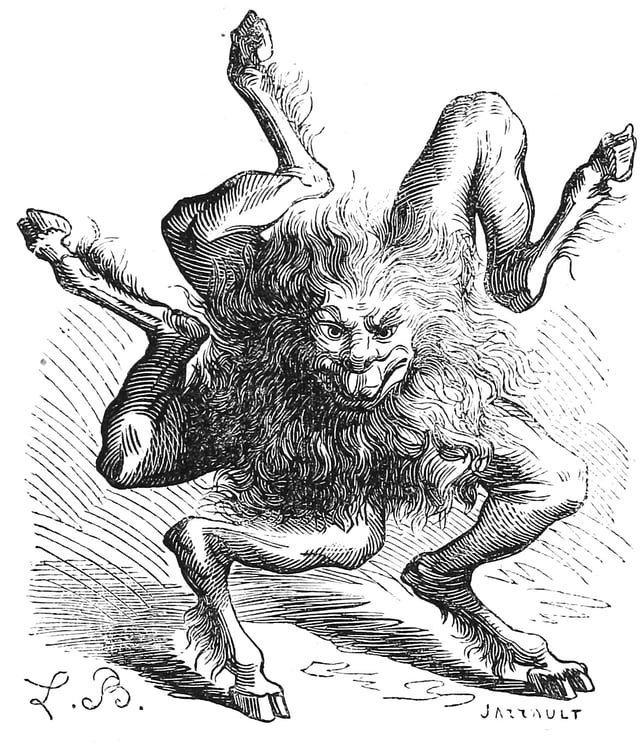
Buer, the 10th spirit, who teaches "Moral and Natural Philosophy" (illustration by Louis Breton from Dictionnaire Infernal
The Ancient Greek word δαίμων daemon denotes a spirit or divine power, much like the Latin genius or numen. Daimōn most likely came from the Greek verb daiesthai (to divide, distribute).[2] The Greek conception of a daimōn notably appears in the works of Plato, where it describes the divine inspiration of Socrates. The original Greek word daimon does not carry the negative connotation initially understood by implementation of the Koine δαιμόνιον (daimonion),[1] and later ascribed to any cognate words sharing the root.
The Greek terms do not have any connotations of evil or malevolence.
In fact, εὐδαιμονία eudaimonia, (literally good-spiritedness) means happiness. By the early Roman Empire, cult statues were seen, by pagans and their Christian neighbors alike, as inhabited by the numinous presence of the gods: "Like pagans, Christians still sensed and saw the gods and their power, and as something, they had to assume, lay behind it, by an easy traditional shift of opinion they turned these pagan daimones into malevolent 'demons', the troupe of Satan..... Far into the Byzantine period Christians eyed their cities' old pagan statuary as a seat of the demons' presence. It was no longer beautiful, it was infested."[4] The term had first acquired its negative connotations in the Septuagint translation of the Hebrew Bible into Greek, which drew on the mythology of ancient Semitic religions. This was then inherited by the Koine text of the New Testament. The Western medieval and neo-medieval conception of a demon [5] derives seamlessly from the ambient popular culture of Late Antiquity. The Hellenistic "daemon" eventually came to include many Semitic and Near Eastern gods as evaluated by Christianity.
The supposed existence of demons remains an important concept in many modern religions and occultist traditions.
Demons are still feared largely due to their alleged power to possess living creatures. In the contemporary Western occultist tradition (perhaps epitomized by the work of Aleister Crowley), a demon (such as Choronzon, which is Crowley's interpretation of the so-called 'Demon of the Abyss') is a useful metaphor for certain inner psychological processes (inner demons), though some may also regard it as an objectively real phenomenon. Some scholars[6] believe that large portions of the demonology (see Asmodai) of Judaism, a key influence on Christianity and Islam, originated from a later form of Zoroastrianism, and were transferred to Judaism during the Persian era.
Ancient Egypt

Ram-headed demon.
Both deities and demons can act as intermediaries to deliver messages to humans.[7] Thus they share some resemblance to the Greek daimonion. The exact definition of "demon" in Egyptology posed a major problem for modern scholarship, since the borders between a deity and a demon are sometimes blurred and the ancient Egyptian language lacks a term for the modern English "demon".[7][9]Demons%20and%20Illness%20f]]However, magical writings indicate that ancient Egyptians acknowledged the existence of malevolent demons by highlighting the demon names with red ink.[[9]](https://openlibrary.org/search?q=Siam%20Bhayro%2C%20Catherine%20Rider%20 [[CITE|9|https://openlibrary.org/search?q=Siam%20Bhayro%2C%20Catherine%20Rider%20*Demons%20and%20Illness%20f) nally acted independent from the divine will. The existence of demons can be related to the realm of chaos, beyond the created world.[7]
Ancient Egyptian demons can be divided into two classes: "guardians" and "wanderers."[7][9]Demons%20and%20Illness%20f]]"Guardians" are tied to a specific place; their demonic activity is topographically defined and their function can be benevolent towards those who have the secret knowledge to face them.[12]]]Demons protecting the underworld may prevent human souls from entering paradise. Only by knowing right charms is the deceased able to enter the.[[13]](https://openlibrary.org/search?q=Dorian%20Gieseler%20Greenbaum%20* [[CITE|13|https://openlibrary.org/search?q=Dorian%20Gieseler%20Greenbaum%20*The%20Daimon%20in%20Hellenist) ded sacred places or the gates to the netherworld. During the Ptolemaic and Roman period, the guardians shifted towards the role of Genius loci and they were the focus of local and private cults.
The "wanderers" are associated with possession, mental illness, death and plagues.
Many of them serve as executioners for the major deities, such as Ra or Osiris, when ordered to punish humans on earth or in the netherworld.[7] Wanderers can also be agents of chaos, arising from the world beyond creation to bring about misfortune and suffering without any divine instructions, led only by evil motivations. The influences of the wanderers can be warded off and kept at the borders on the human world by the use of magic, but they can never be destroyed. A sub-category of "wanderers" are nightmare demons, which were believed to cause nightmares by entering a human body.[7]
Mesopotamia
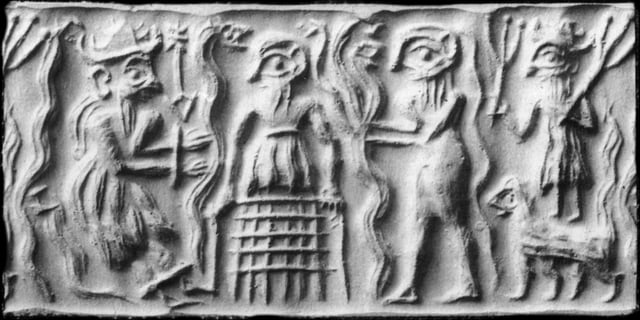
Ancient Sumerian cylinder seal impression showing the god Dumuzid being tortured in the Underworld by galla
From Chaldea, the term shedu traveled to the Israelites. The writers of the Tanach applied the word as a dialogism to Canaanite deities.
There are indications that demons in popular Hebrew mythology were believed to come from the nether world.[16] Various diseases and ailments were ascribed to them, particularly those affecting the brain and those of internal nature.
Examples include catalepsy, headache, epilepsy and nightmares.
There also existed a demon of blindness, "Shabriri" (lit.
"dazzling glare") who rested on uncovered water at night and blinded those who drank from it.[17]
Demons supposedly entered the body and caused the disease while overwhelming or "seizing" the victim.
To cure such diseases, it was necessary to draw out the evil demons by certain incantations and talismanic performances, at which the Essenes excelled.[14] Josephus, who spoke of demons as "spirits of the wicked which enter into men that are alive and kill them", but which could be driven out by a certain root,[18] witnessed such a performance in the presence of the Emperor Vespasian[19] and ascribed its origin to King Solomon. In mythology, there were few defences against Babylonian demons. The mythical mace Sharur had the power to slay demons such as Asag, a legendary gallu or edimmu of hideous strength.
Abrahamic religions
Judaism
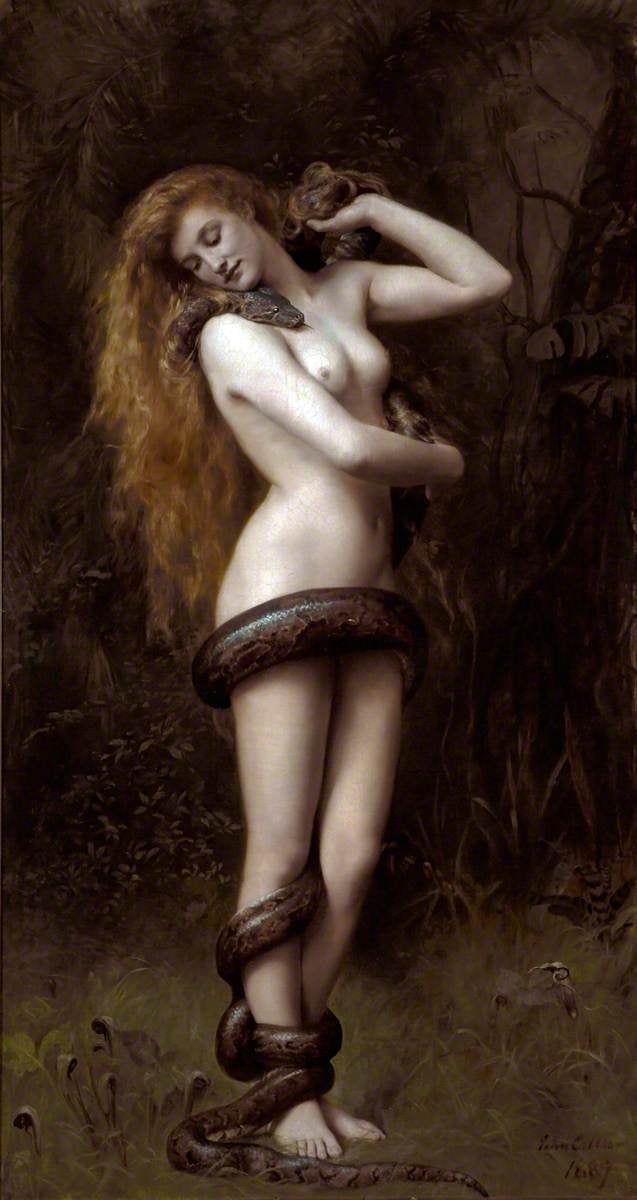
In Lilith by John Collier (1892), the female demon Lilith is shown personified within the Garden of Eden
As referring to the existence or non-existence of demons (shedim or Se'irim) there are converse opinions in Judaism.[14] There are "practically nil" roles assigned to demons in the Hebrew Bible.[20] In Judaism today, beliefs in "demons" or "evil spirits" are either hasidut (Hebr. for "customs of the pious"), and therefore not halachah, or notions based on a superstition that are non-essential, non-binding parts of Judaism, and therefore not normative Jewish practice. That is to say, Jews are not obligated to believe in the existence of shedim, as posek rabbi David Bar-Hayim points out.[21]
Tanakh
The Tanakh mentions two classes of demonic spirits, the se'irim and the shedim. The word shedim appears in two places in the Tanakh (Psalm 106:37 [99], Deuteronomy 32:17 [100] ). The se'irim are mentioned once in Leviticus 17:7 [101] ,[22] probably a re-calling of Assyrian demons in shape of goats.[23]Philosophical%20Appr]]The ot pagan demigods, but the foreign gods themselves. Both entities appear in a scriptural context of animal or child sacrifice to "non-existent" false gods.[14][20][24]
Talmudic tradition
In the Jerusalem Talmud notions of shedim ("demons" or "spirits") are almost unknown or occur only very rarely, whereas in the Babylon Talmud there are many references to shedim and magical incantations. The existence of shedim in general was not questioned by most of the Babylonian Talmudists. As a consequence of the rise of influence of the Babylonian Talmud over that of the Jerusalem Talmud, late rabbis in general took as fact the existence of shedim, nor did most of the medieval thinkers question their reality. However, rationalists like Maimonides, Saadia Gaon and Abraham ibn Ezra and others explicitly denied their existence, and completely rejected concepts of demons, evil spirits, negative spiritual influences, attaching and possessing spirits. Their point of view eventually became mainstream Jewish understanding.[14][25]
Kabbalah
In Kabbalah demons are regarded a necessary part of the divine emanation in the material world and a byproduct of human sin (Qliphoth).[26]The%20Encyclopedia%20of%20Jewish%20Myt]]However spirits such as the shedim may also be benevolent and were used in kabbalistic ceremonies (as with the golem edim* (Mazikin
Aggadah
Aggadic tales from the Persian tradition describe the shedim, the mazziḳim ("harmers"), and the ruḥin ("spirits"). There were also lilin ("night spirits"), ṭelane ("shade", or "evening spirits"), ṭiharire ("midday spirits"), and ẓafrire ("morning spirits"), as well as the "demons that bring famine" and "such as cause storm and earthquake".[28][14] According to some aggadic stories, demons were under the dominion of a king or chief, either Asmodai[29] or, in the older Aggadah, Samael ("the angel of death"), who killed via poison. Stories in the fashion of this kind of folklore never became an essential feature of Jewish theology.[25] Although occasionally an angel is called satan in the Babylon Talmud, this does not refer to a demon: "Stand not in the way of an ox when coming from the pasture, for Satan dances between his horns".[30]
Second Temple period texts
To the Qumran community during the Second Temple period this apotropaic prayer was assigned, stating: "And, I the Sage, declare the grandeur of his radiance in order to frighten and terri[fy] all the spirits of the ravaging angels and the bastard spirits, demons, Liliths, owls" (Dead Sea Scrolls, "Songs of the Sage," Lines 4–5).[31][32]
In the Dead Sea Scrolls, there exists a fragment entitled "Curses of Belial" (Curses of Belial (Dead Sea Scrolls, 394, 4Q286(4Q287, fr. 6)=4QBerakhot)). This fragment holds much rich language that reflects the sentiment shared between the Qumran towards Belial. In many ways this text shows how these people thought Belial influenced sin through the way they address him and speak of him. By addressing "Belial and all his guilty lot," (4Q286:2) they make it clear that he is not only impious, but also guilty of sins. Informing this state of uncleanliness are both his "hostile" and "wicked design" (4Q286:3,4). Through this design, Belial poisons the thoughts of those who are not necessarily sinners. Thus a dualism is born from those inclined to be wicked and those who aren't.[33] It is clear that Belial directly influences sin by the mention of "abominable plots" and "guilty inclination" (4Q286:8,9). These are both mechanisms by which Belial advances his evil agenda that the Qumran have exposed and are calling upon God to protect them from. There is a deep sense of fear that Belial will "establish in their heart their evil devices" (4Q286:11,12). This sense of fear is the stimulus for this prayer in the first place. Without the worry and potential of falling victim to Belial's demonic sway, the Qumran people would never feel impelled to craft a curse. This very fact illuminates the power Belial was believed to hold over mortals, and the fact that sin proved to be a temptation that must stem from an impure origin.
In Jubilees 1:20, Belial's appearance continues to support the notion that sin is a direct product of his influence. Moreover, Belial's presence acts as a placeholder for all negative influences or those that would potentially interfere with God's will and a pious existence. Similarly to the "gentiles... [who] cause them to sin against you" (Jubilees 1:19), Belial is associated with a force that drives one away from God. Coupled in this plea for protection against foreign rule, in this case the Egyptians, is a plea for protection from "the spirit of Belial" (Jubilees 1:19). Belial's tendency is to "ensnare [you] from every path of righteousness" (Jubilees 1:19). This phrase is intentionally vague, allowing room for interpretation. Everyone, in one way or another, finds themselves straying from the path of righteousness and by pawning this transgression off on Belial, he becomes a scapegoat for all misguidance, no matter what the cause. By associating Belial with all sorts of misfortune and negative external influence, the Qumran people are henceforth allowed to be let off for the sins they commit.
Belial's presence is found throughout the War Scrolls, located in the Dead Sea Scrolls, and is established as the force occupying the opposite end of the spectrum of God.
In Col. I, verse 1, the very first line of the document, it is stated that "the first attack of the Sons of Light shall be undertaken against the forces of the Sons of Darkness, the army of Belial" (1Q33;1:1).[34] This dichotomy sheds light on the negative connotations that Belial held at the time.[33] Where God and his Sons of Light are forces that protect and promote piety, Belial and his Sons of Darkness cater to the opposite, instilling the desire to sin and encouraging destruction. This opposition is only reinforced later in the document; it continues to read that the "holy ones" will "strike a blow at wickedness", ultimately resulting in the "annihilation of the Sons of Darkness" (1Q33:1:13). This epic battle between good and evil described in such abstract terms, however it is also applicable to everyday life and serves as a lens through which the Qumran see the world. Every day is the Sons of Light battle evil and call upon God to help them overcome evil in ways small and large.
Belial's influence is not taken lightly.
In Col. XI, verse 8, the text depicts God conquering the "hordes of Belial" (1Q33;11:8).
This defeat is indicative of God's power over Belial and his forces of temptation.
However the fact that Belial is the leader of hordes is a testament to how persuasive he can be.
If Belial was obviously an arbiter of wrongdoing and was blatantly in the wrong, he wouldn't be able to amass an army.
This fact serves as a warning message, reasserting God's strength, while also making it extremely clear the breadth of Belial's prowess.
Belial's "council is to condemn and convict", so the Qumran feel strongly that their people are not only aware of his purpose, but also equipped to combat his influence (1Q33;13:11).
In the Damascus Document, Belial also makes a prominent appearance, being established as a source of evil and an origin of several types of sin. In Column 4, the first mention of Belial reads: "Belial shall be unleashed against Israel" (4Q266). This phrase is able to be interpreted myriad different ways. Belial is characterized in a wild and uncontrollable fashion, making him seem more dangerous and unpredictable. The notion of being unleashed is such that once he is free to roam; he is unstoppable and able to carry out his agenda uninhibited. The passage then goes to enumerate the "three nets" (4Q266;4:16) by which Belial captures his prey and forces them to sin. "Fornication..., riches..., [and] the profanation of the temple" (4Q266;4:17,18) make up the three nets. These three temptations were three agents by which people were driven to sin, so subsequently, the Qumran people crafted the nets of Belial to rationalize why these specific temptations were so toxic. Later in Column 5, Belial is mentioned again as one of "the removers of bound who led Israel astray" (4Q266;5:20). This statement is a clear display of Belial's influence over man regarding sin. The passage goes on to state: "they preached rebellion against... God" (4Q266;5:21,22). Belial's purpose is to undermine the teachings of God, and he achieves this by imparting his nets on humans, or the incentive to sin.[34]
Christianity
Old Testament
Demonic entities in the Old Testament of the Christian Bible are of two classes: the "satyrs" or "shaggy goats" (from Hebr. se'irim "hairy beings", "he-goats" or "fauns"; Isaiah 13:21, 34:14)[39] and the "demons" (from Hebr. shedim first translated as Greek: δαιμόνιον daimonion, "daemon"; 106:35–39, 32:17).
New Testament
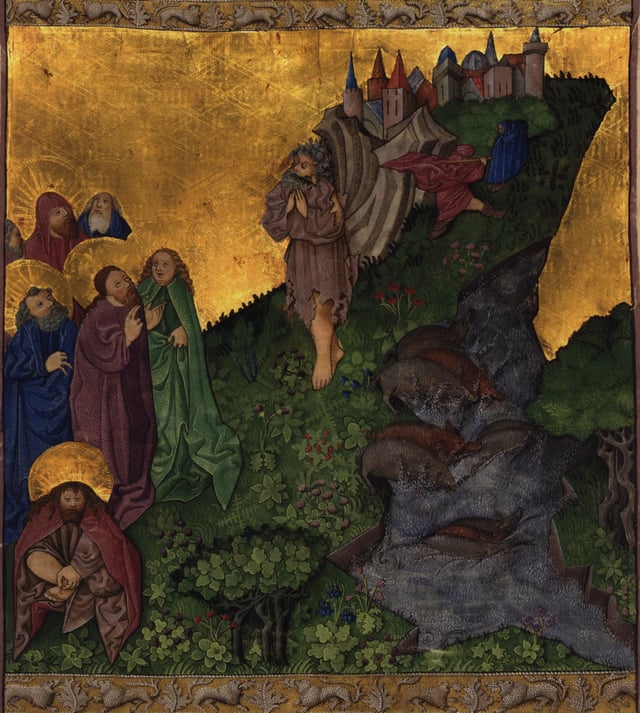
Medieval illumination from the Ottheinrich Folio depicting the exorcism of the Gerasene demoniac by Jesus
The term demon (from the Koine Greek δαιμόνιον daimonion) appears 63 times in the New Testament of the Christian Bible, mostly if not all relating to occurrences of possession of individuals and exorcism by Jesus.[40][41][42]
Pseudepigrapha and Deuterocanonical books
Demons are sometimes included into biblical interpretation.
In the story of Passover, the Bible tells the story as "the Lord struck down all the firstborn in Egypt" (Exodus 12:21–29).
In the Book of Jubilees, which is considered canonical only by the Ethiopian Orthodox Church,[43]
In the Genesis flood narrative the author explains how God was noticing "how corrupt the earth had become, for all the people on earth had corrupted their ways" (Genesis 6:12). In Jubilees the sins of man are attributed to "the unclean demons [who] began to lead astray the children of the sons of Noah, and to make to err and destroy them" (Jubilees 10:1). In Jubilees Mastema questions the loyalty of Abraham and tells God to "bid him offer him as a burnt offering on the altar, and Thou wilt see if he will do this command" (Jubilees 17:16). The discrepancy between the story in Jubilees and the story in Genesis 22 exists with the presence of Mastema. In Genesis, God tests the will of Abraham merely to determine whether he is a true follower, however; in Jubilees Mastema has an agenda behind promoting the sacrifice of Abraham's son, "an even more demonic act than that of the Satan in Job."[44] In Jubilees, where Mastema, an angel tasked with the tempting of mortals into sin and iniquity, requests that God give him a tenth of the spirits of the children of the watchers, demons, in order to aid the process.[45] These demons are passed into Mastema’s authority, where once again, an angel is in charge of demonic spirits.
The sources of demonic influence were thought to originate from the Watchers or Nephilim, who are first mentioned in Genesis 6 and are the focus of 1 Enoch Chapters 1–16, and also in Jubilees 10. The Nephilim were seen as the source of the sin and evil on earth because they are referenced in Genesis 6:4 before the story of the Flood.[47] In Genesis 6:5, God sees evil in the hearts of men. The passage states, "the wickedness of humankind on earth was great", and that "Every inclination of the thoughts of their hearts was only continually evil" (Genesis 5). The mention of the Nephilim in the preceding sentence connects the spread of evil to the Nephilim. Enoch is a very similar story to Genesis 6:4–5, and provides further description of the story connecting the Nephilim to the corruption of humans. In Enoch, sin originates when angels descend from heaven and fornicate with women, birthing giants as tall as 300 cubits. The giants and the angels' departure of Heaven and mating with human women are also seen as the source of sorrow and sadness on Earth. The book of Enoch shows that these fallen angels can lead humans to sin through direct interaction or through providing forbidden knowledge. In Enoch, Semyaz leads the angels to mate with women. Angels mating with humans is against God's commands and is a cursed action, resulting in the wrath of God coming upon Earth. Azazel indirectly influences humans to sin by teaching them divine knowledge not meant for humans. Asael brings down the "stolen mysteries" (Enoch 16:3). Asael gives the humans weapons, which they use to kill each other. Humans are also taught other sinful actions such as beautification techniques, alchemy, astrology and how to make medicine (considered forbidden knowledge at the time). Demons originate from the evil spirits of the giants that are cursed by God to wander the earth. These spirits are stated in Enoch to "corrupt, fall, be excited, and fall upon the earth, and cause sorrow" (Enoch 15:11).[48]
The Book of Jubilees conveys that sin occurs when Cainan accidentally transcribes astrological knowledge used by the Watchers (Jubilees 8).
This differs from Enoch in that it does not place blame on the Angels.
However, in Jubilees 10:4 the evil spirits of the Watchers are discussed as evil and still remain on earth to corrupt the humans.
God binds only 90 percent of the Watchers and destroys them, leaving 10 percent to be ruled by Mastema.
Because the evil in humans is great, only 10 percent would be needed to corrupt and lead humans astray.
These spirits of the giants also referred to as "the bastards" in the Apotropaic prayer Songs of the Sage, which lists the names of demons the narrator hopes to expel.[49]
Christian demonology
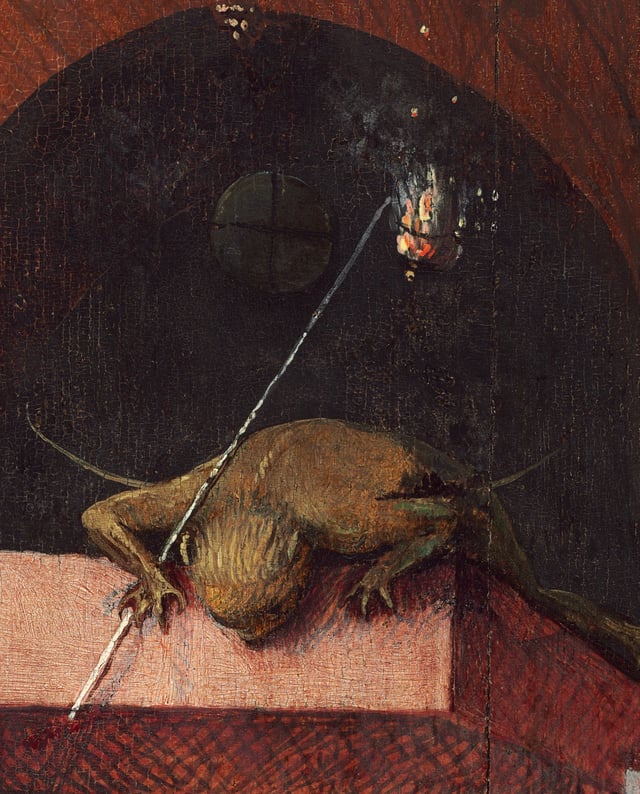
Death and the Miser (detail), a Hieronymus Bosch painting, National Gallery of Art, Washington, D.C.
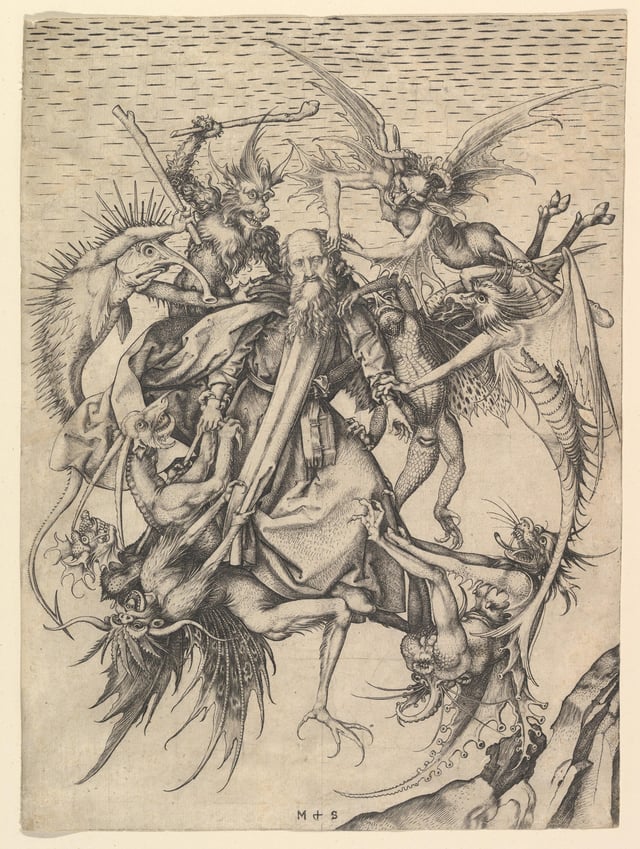
St. Anthony the Great plagued by demons, engraving by Martin Schongauer in the 1480s.
In Christianity, demons are corrupted spirits carrying the execution of Satan's desires.
They are generally regarded as three different types of spirits:
Souls of the wicked deceased, which roam the earth to torment the living.[50]
Nephilim, who came into being by union between angels and human, but their bodily part were wiped out during the Great flood. Their spiritual part now desires reembodiment.[51][52]
Fallen angels, who sided with Lucifer and were cast out of heaven by Michael after battle.
Often deities of other religions are interpreted or identified as such "demons" (from the Greek Old Testament δαιμόνιον daimonion).[53] The evolution of the Christian Devil and pentagram are examples of early rituals and images that showcase evil qualities, as seen by the Christian churches.
Since Early Christianity, demonology has developed from a simple acceptance of demons to a complex study that has grown from the original ideas taken from Jewish demonology and Christian scriptures.[54] Christian demonology is studied in depth within the Roman Catholic Church,[55] although many other Christian churches affirm and discuss the existence of demons.[56][57]
Building upon the few references to daemons in the New Testament, especially the poetry of the Book of Revelation, Christian writers of apocrypha from the 2nd century onwards created a more complicated tapestry of beliefs about "demons" that was largely independent of Christian scripture.
The contemporary Roman Catholic Church unequivocally teaches that angels and demons are real beings rather than just symbolic devices.
The Catholic Church has a cadre of officially sanctioned exorcists which perform many exorcisms each year. The exorcists of the Catholic Church teach that demons attack humans continually but that afflicted persons can be effectively healed and protected either by the formal rite of exorcism, authorized to be performed only by bishops and those they designate, or by prayers of deliverance, which any Christian can offer for themselves or others.[58]
At various times in Christian history, attempts have been made to classify demons according to various proposed demonic hierarchies.
In the Gospels, particularly the Gospel of Mark, Jesus cast out many demons from those afflicted with various ailments. He also lent this power to some of his disciples (Luke 10:17 [102] ).
Apuleius, by Augustine of Hippo, is ambiguous as to whether daemons had become "demonized" by the early 5th century:
He [Apulieus] also states that the blessed are called in Greek eudaimones, because they are good souls, that is to say, good demons, confirming his opinion that the souls of men are demons.[59]
Islam
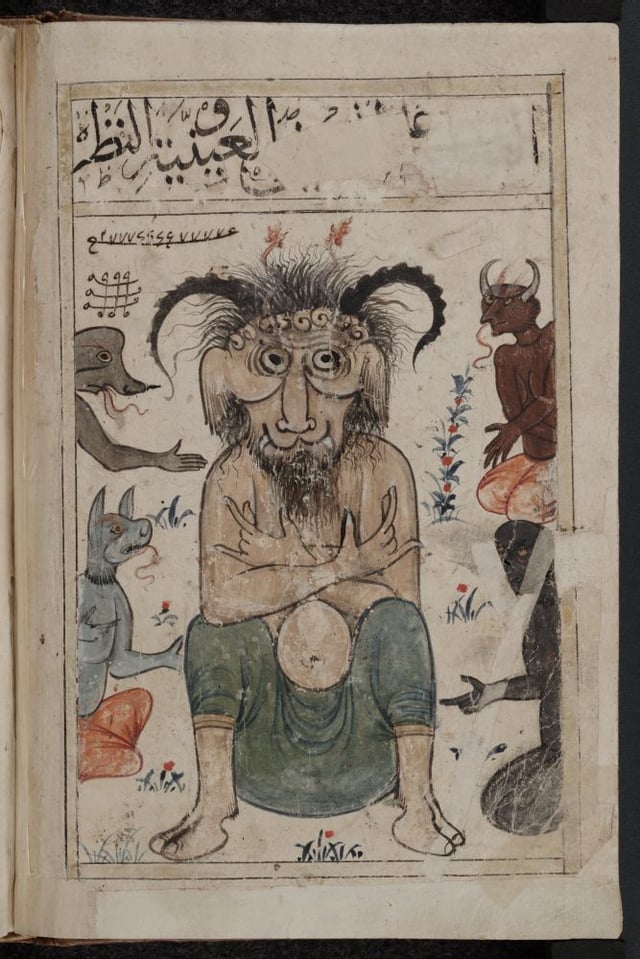
Demons depicted in the Book of Wonders, a late 14th century Arabic manuscript
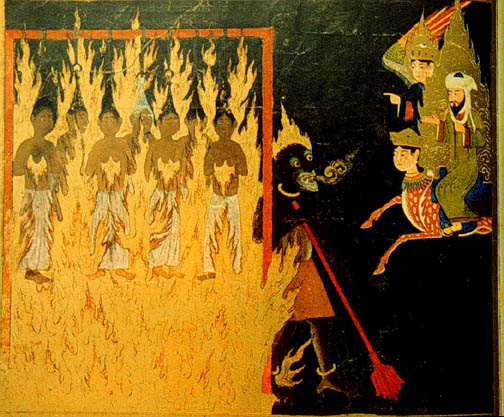
Depiction of a member of the Zabaniyya
Islam and Islam-related beliefs acknowledges the concept of evil spirits known as malevolent jinn, afarit and shayatin. Unlike the belief in angels, belief in demons is not obligated by the six articles of Islamic faith.[60] However, the existence of several demonic spirits is generally assumed by Islamic theology and further elaborated beliefs persist in Islamic folklore. The Div, probably adapted under Zorastrian influences, became another prominent demonic creature in Islamic culture. Just like jinn, they are able to possess humans, but differ from jinn and shayatin in their physical strenght,PARTOVI, P. (2009), Girls' Dormitory: Women's Islam and Iranian Horror. Visual Anthropology Review, 25: 186-207. doi:10.1111/j.1548-7458.2009.01041.x thus also equated with Ogres[61] in Turkish language. They are in constant war with peri,[62] a benevolent spirit,[63] also originated in Persian lore. Furthermore the Quran mentions the Zabaniyya, who torture the damned in hell, who may have originated from a class of Arabian demons.[64] However, their execution of punishment is in accordance with God’s order, therefore they are not equalized with shayatin, who in turn are rebellious against the divine will.
Jinn and shayatin
Rather than demonic, jinn are depicted as close to humans regarded as living in societies, in need of dwelling places, eating and drinking, and although their lifespan exceeds those of humans over centuries, they die and also need to procreate, but because they are created from smokeless fire in contrast to humans made from solid earth, the latter can not see them. As for humans, jinn are also subject to temptations of the shayatin and Satan therefore may either be good or evil.[65] Evil jinn are comparable to demons, scaring or possessing humans. In folklore some jinn may also lurk on lonely travelers to dissuade them from their paths and eat their corpses. Although not evil, a jinni may haunt a person, because it feels offended by him. Islam has no binding origin story of jinn, but Islamic beliefs commonly assume that the jinn were created on a Thursday thousands of years before mankind. Therefore Islamic medieval narratives often called them pre-Adamites.[66]Islam%2C%20Arabs%2C%20and%20Intelligent%20World]]However, just like shayatin, jinn are held responsible for various deceases and possession. Further both can be summoned and subjugated by magicians.[[67]](https://openlibrary.org/search?q=Siam%20Bhayro%2C%20Catherine%20Rider%20 [[CITE|9|https://openlibrary.org/search?q=Siam%20Bhayro%2C%20Catherine%20Rider%20*Demons%20and%20Illness%20f)[68]
Otherwise the shayatin are the Islamic equivalent of "demons" in western usage.[69] Islam differs in regard of the origin of demons.
They may either be a class of heavenly creatures cast out of heaven or the descendants of Iblis.[70]Legends%20of%20the%20Fire%20Spirits%3A%20Jinn%20]]Unlike jinn and humans, shayatin are immortal and will meet their end when the world ceases to exist, however prayers could dissolve or banish them.[[71]](https://openlibrary.org/search?q=Hajjah%20Amina%20Adil%20 [[CITE|71|https://openlibrary.org/search?q=Hajjah%20Amina%20Adil%20*Muhammad%20the%20Messenger%20of%20Islam) en, but are chased away from the angels or shooting stars. The shayatin usually do not possess people, but "whisper" to their minds and seduce them into falsehood and sin. These are called waswās and may enter the hearts of humans to support negative feelings, especially in states of strong emotion like depression or anger.[72]
Ifrit
Another demonic spirit is called ifrit and although there are no descriptions regarding an iftrit's behavior found in Islamic canonical texts, Folk Islam often depicts them with traits of malevolent ghosts, returning after death or a subcategory of shayatin drawn the life-force of those who were murdered. Moreover, they are not exactly shayatin since they differ in their origin.[65]
Bahá'í Faith
In the Bahá'í Faith, demons are not regarded as independent evil spirits as they are in some faiths. Rather, evil spirits described in various faiths' traditions, such as Satan, fallen angels, demons and jinn, are metaphors for the base character traits a human being may acquire and manifest when he turns away from God and follows his lower nature. Belief in the existence of ghosts and earthbound spirits is rejected and considered to be the product of superstition.[74]
Ceremonial magic
While some people fear demons, or attempt to exorcise them, others willfully attempt to summon them for knowledge, assistance, or power.
The ceremonial magician usually consults a grimoire, which gives the names and abilities of demons as well as detailed instructions for conjuring and controlling them. Grimoires are not limited to demons – some give the names of angels or spirits which can be called, a process called theurgy. The use of ceremonial magic to call demons is also known as goetia, the name taken from a section in the famous grimoire known as the Lesser Key of Solomon.[75]
Hinduism
Hindu beliefs include numerous varieties of spirits that might be classified as demigods, including Vetalas, Bhutas and Pishachas. Rakshasas and Asuras are often misunderstood to be demons.
Asuras
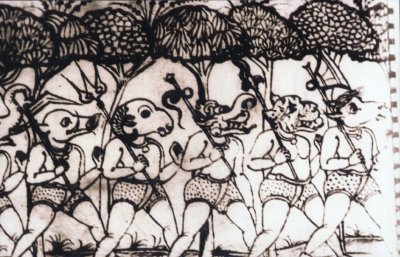
The Army of Super Creatures – from The Saugandhika Parinaya Manuscript (1821 CE)
Asura, in the earliest hymns of the Rigveda, originally meant any supernatural spirit, either good or bad. Since the /s/ of the Indic linguistic branch is cognate with the /h/ of the Early Iranian languages, the word Asura, representing a category of celestial beings, is a cognate of Ahura (Mazda), the Supreme God of the monotheistic Zoroastrians. Ancient Hinduism tells that Devas (also called suras) and Asuras are half-brothers, sons of the same father Kashyapa; although some of the Devas, such as Varuna, are also called Asuras. Later, during Puranic age, Asura and Rakshasa came to exclusively mean any of a race of anthropomorphic, powerful, possibly evil beings. Daitya (lit. sons of the mother "Diti"), Maya Danava, Rakshasa (lit. from "harm to be guarded against"), and Asura are incorrectly translated into English as "demon".
In post-Vedic Hindu scriptures, pious, highly enlightened Asuras, such as Prahlada and Vibhishana, are not uncommon. The Asura are not fundamentally against the gods, nor do they tempt humans to fall. Many people metaphorically interpret the Asura as manifestations of the ignoble passions in the human mind and as symbolic devices. There were also cases of power-hungry Asuras challenging various aspects of the gods, but only to be defeated eventually and seek forgiveness.
Evil spirits
Hinduism advocates the reincarnation and transmigration of souls according to one's karma. Souls (Atman) of the dead are adjudged by the Yama and are accorded various purging punishments before being reborn. Humans that have committed extraordinary wrongs are condemned to roam as lonely, often mischief mongers, spirits for a length of time before being reborn. Many kinds of such spirits (Vetalas, Pishachas, Bhūta) are recognized in the later Hindu texts.
Iranian demons
Zoroastrianism
Evil spirits are the creation of the evil principle Ahriman in Zoroastrian cosmology, commonly referred to as Daeva. The first six archdemons are produced by Ahriman in direct opposition to the holy immortals created by Ahura Mazda the principle of good. This six archdemons (or seven if Ahriman is included) give existence to uncountable malevolent daeva; the Zorastrian demons. They are the embodiment of evil, causing moral imperfection, destroy, kill and torment the wicked souls in the afterlife.[76]The%20Zo]]Some demons are related to specific vices. Humans in the state of such sin might be possessed by a corresponding demon:[[77]](https://openlibrary.org/search?q=Fereshteh%20Davaran%20 [[CITE|77|https://openlibrary.org/search?q=Fereshteh%20Davaran%20*Continuity%20in%20Iranian%20Identity%3A)
Anger (Kheshm)
Lazyness (Bushyansta)
Envy (Areshk)
Gossip (Spazga)
Grief (Akoman)
Manichaeism
In Manichaean mythology demons had a real existence, as they derived from the Kingdom of Darkness, they were not metaphors expressing the absence of good nor are they fallen angels, that means they are not originally good, but entities purely evil. The demons came into the world after the Prince of Darkness assaulted the Realm of Light. The demons ultimately failed their attack and ended up imprisoned in the structures and matter of the contemporary world.[78] Lacking virtues and being in constant conflict with both the divine creatures and themselves, they are inferior to the divine entities and overcome by the divine beings at the end of time. They are not sophisticated or inventive creatures, but only driven by their urges.[79]
Simultaneously, the Manichaean concept of demons remains abstract and is closely linked to ethical aspects of evil that many of them appear as personified evil qualities such as:[79]
Greed (sexual desire)
Wrath (desire for destruction)
envy
grief
The Watcher, another group of demonic entities, known from the Enochian writings, appear in the canonical Book of Giants. The Watchers came into existence after the demons were chained up in the sky by Living Spirit. Later, outwitted by Third Messenger, they fall to earth, there they had intercourse with human women and beget the monstrous Nephilim. Thereupon they establish a tyrannical rule on earth, suppressing mankind, until they are defeated by the angels of punishment, setting an end to their rule.[80]
Native North American demons
Wendigo
The Algonquian people traditionally believe in a spirit called a wendigo. The spirit is believed to possess people who then become cannibals. In Athabaskan folklore, there is a belief in wechuge, a similar cannibal sprit.
Wicca
According to Rosemary Ellen Guiley, "Demons are not courted or worshipped in contemporary Wicca and Paganism. The existence of negative energies is acknowledged."[81]
Modern interpretations
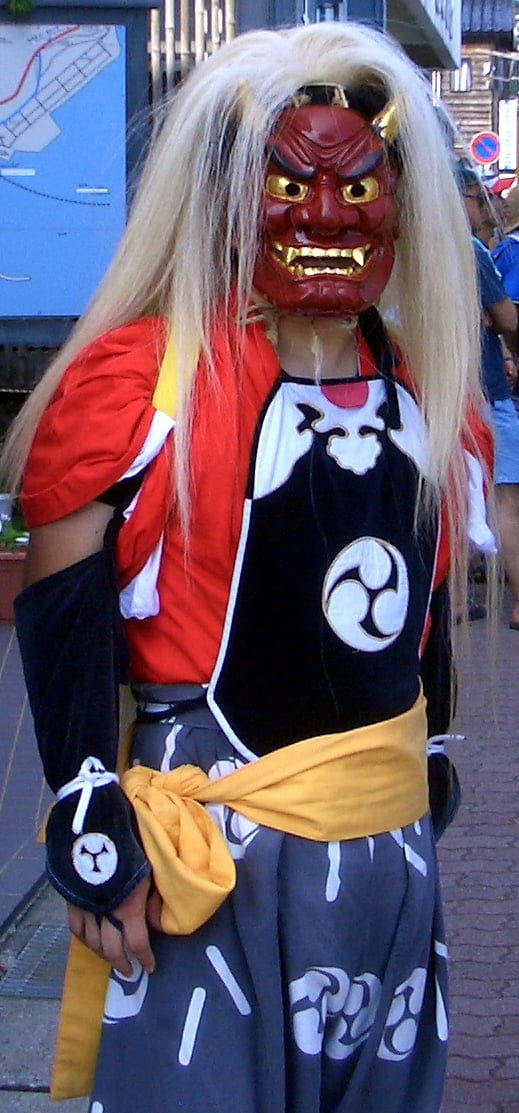
The classic Oni, an Japanese ogre-like creature which often has horns and often translated into English as "demon".
Psychologist Wilhelm Wundt remarked that "among the activities attributed by myths all over the world to demons, the harmful predominate, so that in popular belief bad demons are clearly older than good ones."[82] Sigmund Freud developed this idea and claimed that the concept of demons was derived from the important relation of the living to the dead: "The fact that demons are always regarded as the spirits of those who have died recently shows better than anything the influence of mourning on the origin of the belief in demons."[83]
M. Scott Peck, an American psychiatrist, wrote two books on the subject, People of the Lie: The Hope For Healing Human Evil[84]People%20of%20the%20Lie%3A%20The%20Hope%20F]]and al Accounts of Possession, Exorcism, and Redemption*.[[85]](https://openlibrary.org/search?q=Peck%2C%20M.%20S.%20%282005%29.%20* [[CITE|85|https://openlibrary.org/search?q=Peck%2C%20M.%20S.%20%282005%29.%20*Glimpses%20of%20the%20Devil%3A%20A%20Psyc)People of the Lieovides identifying characteristics of an evil person, whom he classified as having a character disorder. In Glimpses of the Devil Peck goes into significant detail describing how he became interested in exorcism in order to debunk the myth of possession by evil spirits – only to be convinced otherwise after encountering two cases which did not fit into any category known to psychology or psychiatry. Peck came to the conclusion that possession was a rare phenomenon related to evil and that possessed people are not actually evil; rather, they are doing battle with the forces of evil.[86]
Although Peck's earlier work was met with widespread popular acceptance, his work on the topics of evil and possession has generated significant debate and derision.
Much was made of his association with (and admiration for) the controversial Malachi Martin, a Roman Catholic priest and a former Jesuit, despite the fact that Peck consistently called Martin a liar and a manipulator.[87][88] Richard Woods, a Roman Catholic priest and theologian, has claimed that Dr. Peck misdiagnosed patients based upon a lack of knowledge regarding dissociative identity disorder (formerly known as multiple personality disorder) and had apparently transgressed the boundaries of professional ethics by attempting to persuade his patients into accepting Christianity.[87] Father Woods admitted that he has never witnessed a genuine case of demonic possession in all his years.[89][90][91]
According to S. N. Chiu, God is shown sending a demon against Saul in 1 Samuel 16 and 18 in order to punish him for the failure to follow God's instructions, showing God as having the power to use demons for his own purposes, putting the demon under his divine authority.[92] According to the Britannica Concise Encyclopedia, demons, despite being typically associated with evil, are often shown to be under divine control, and not acting of their own devices.[93]
See also
Acheri
Classification of demons
Empusa
Erinyes
Folk devil
Ghoul
Goblin
Holy water#Protection against evil
Imp
List of fictional demons
List of theological demons
Mara
Oni
Spiritual warfare
Theistic Satanism
Yaoguai
Yokai
Zlydzens
